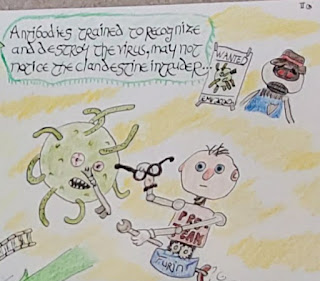Endocytosis: In previous panels, we show the dastardly virus using a disguise to evade the immune system to successfully approach the cell. Its spike protein is initially rotated downward and harder for the immune system to recognize. The virus makes use of a host pro-protein such as furin to properly align the spike protein at the S1/S2 boundary so it can activate the ACE2 receptor to make entry into the cell (endocytosis).
Infiltration and Replication: Once inside, the coronavirus then makes further use of existing human proteins such as cathepsin to unpack its payload and start transcription of its own proteins encoded in its RNA genome. At about 30,000 basepairs, these SARS coronavirus are among the largest and most complex RNA genomes known. So, now that the virus has taken over the cell's fabrication facility, a fleet of new virus particles is being constructed!
So what happens next? Most (lay) descriptions of viral replication just say that the virus causes the cell membrane to rupture so it can surge forth and infect more cells. With most viruses, there is more to it than that and, anyway, with the SARS viruses, particularly SARS-CoV-2 it takes a very different path-- mediated by the "non-structural proteins" in its complex genome which is only partly understood. Programmed cell death, "Apoptosis", does likely happen, but the virus has already spread by then and it is done for a much more cunning reason (which we'll get to in Panel 6).
 | |
| Bat Soup, the Graphic Novel, Panel 5 concept sketch |
This is the structure the virus has taken over. The ribosomes start decoding RNA sequences: cytosine, guanine, adenine, and uracil, and stringing together chains of amino acids, the building blocks of proteins. But finished proteins aren't just strings of amino acids (AAs), they are complex 3D structures. The Endoplasmic Reticulum is where those chains of AAs are folded into completed structures like enzymes or hormones... or the shell of a new virus particle.
Exocytosis: Once the viral structure is fabricated, the replicated RNA strand is placed inside and the whole assembled inside smooth-walled vesicles small bubbles inside the cell which are made out of pieces stolen from the Endoplasmic Reticulum. The result is little packets of virus-laden food service condiment packets (extra spicey!) being arrayed inside the cell. But the virus does not have to burst the cell open to escape. At the command of virus-provided S-proteins, pores form in the surface of the cell and merge with the smooth-walled vesicles, pouring virus into the intercellular space (the spike protein once more disguised) where they can find more cells to infect. This is "exocytosis".
Synctium: But, this virus has another trick for avoiding the immune system, particularly deep in the lungs: it doesn't have to leave the cell to spread. The hostage cell starts leaking S-proteins into the intercellular fluid. The S-proteins cause the cell membranes of nearby cells to merge together. Long multinucleated cells called "synctium" start to form which share the same cytoplasm-- and the same viral infection! As we will see in future panels, the cell, including these multi-nucleates mega-cells, can end up dying several different ways.
This cycle of formation of mega-cells, their destruction, and the body's attempt to heal and regrow tissue is a big reason the virus can cause such massive tissue damage and scarring inside lung tissue. The immune response often makes the situation even worse. Understanding how it works and why some people get away with minimal damage may be a key to effective treatment of severe cases.



No comments:
Post a Comment